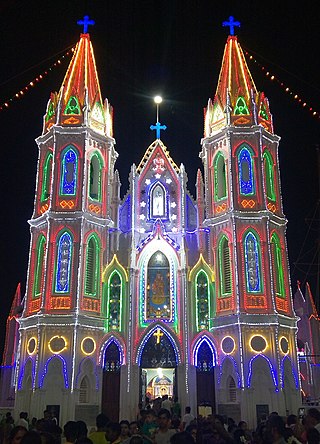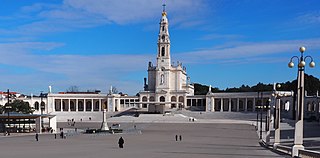

The Church of St. Anne is a church and religious monument located in the Santana district of Old Goa, in Goa province, India. The 17th century church is a major example of the colonial Portuguese Baroque architecture built in Portuguese India. [1]


The Church of St. Anne is a church and religious monument located in the Santana district of Old Goa, in Goa province, India. The 17th century church is a major example of the colonial Portuguese Baroque architecture built in Portuguese India. [1]
Construction of the Church of St. Anne began in 1577 by Monsignor Francisco de Rego (1681–1689). It was completed in 1695, by his successor, Rev. Fr. Antonio Francisco da Cunha.
The Church of Anne was declared a "national monument" during the Portuguese era per Government Portario No. 1360 of 31/3/31. In that Portario were also the Bom Jesus Basilica, the Se Cathedral, the Church of St. Francis of Assisi, the Convent of Santa Monica and the Church of St. Cajetan. Each of these, monumental in their architectural splendor, and all of them within the former Portuguese capital of Old Goa, Goa.
Upon Goa's annexation by India in 1961, while the aforementioned edifices were embraced as "national monuments" by the Archaeological Survey of India (ASI) and effectively taken over, the church of St. Anne was singularly overlooked and suffered the ravages of time and human neglect until parts of the structure were in precarious conditions.
The Church has been taken under the wing of the World Monument Foundation. Urgent repairs and the strengthening of the foundations took place in 2007 along with assistance from the Goa Government. [2]
Legend has it that while construction was in progress, an elderly villager by the name of Bartholomeu Marchon, had a vision of an old lady donning a hat with a staff in hand. The old lady ambled down the neighboring hill and promulgated to Bartholomeu that the Church under construction was her home, and that it was her intent to reside there. A similar apparition was also encountered by a Brahmin lady of high social standing, who happened to be gravely ill and almost in death's clutch. The celestial apparition anointed the lady with a miraculous cure and as a token of supreme gratitude, she embraced Christianity. Word of her miraculous cure percolated down to the village priest who instantly interpreted it as a sign of divine intervention, and without further ado, consecrated the church in honor of St. Anne. [3]
High up in the transept facing the sanctuary, one can see a relief picture depicting the scene of St. Anne with a staff in hand and wearing a hat as seen in the apparitions..

Francis Xavier, SJ, venerated as Saint Francis Xavier, was a Spanish Navarrese Catholic missionary and saint who was a co-founder of the Society of Jesus.
Old Goa is a historical site and city situated on the southern banks of the River Mandovi, within the Tiswadi taluka (Ilhas) of North Goa district, in the Indian state of Goa.

Ponda, is a city and a municipal council in the South Goa district of Goa, India. Located in the central area of Goa, Ponda lies 28 km southeast of Panaji, the capital of Goa and 17 km northeast of Margao, the district headquarters. Ponda is also known as "Antruz Mahal" because of the presence of numerous famous temples and rich cultural heritage.

Ribandar is a town in Tiswadi, Goa, located between the cities of Panjim and Old Goa.

The Basilica of Bom Jesus is a Catholic basilica located in Goa, in the Konkan region of India. The iconic church is a pilgrimage centre and recognised by UNESCO as a World Heritage Site. The basilica is located in Old Goa, the former capital of Portuguese India, and holds the mortal remains of St Francis Xavier.

Our Lady of Lourdes is a title of the Virgin Mary. She is venerated under this title by the Roman Catholic church due to her apparitions that occurred in Lourdes, France. The first apparition of 11 February 1858, of which Bernadette Soubirous told her mother that a "Lady" spoke to her in the cave of Massabielle while she was gathering firewood with her sister and a friend. Similar apparitions of the "Lady" were reported on 18 occasions that year, until the climax revelation in which she introduced herself as: "I am the Immaculate Conception". On 18 January 1862, the local Bishop of Tarbes Bertrand-Sévère Laurence endorsed the veneration of the Blessed Virgin Mary in Lourdes.

Our Lady of Good Health, also known as Our Lady of Vailankanni, is a title given to the Blessed Virgin Mary by devotees. She is said to have appeared twice in the town of Velankanni, Tamil Nadu, India, in the 16th to 17th centuries.

The Basilica of Our Lady of Good Health, also known as Sanctuary of Our Lady of Velankanni, is a Marian shrine located at the town of Velankanni in Tamil Nadu, India. The place is also a minor basilica of the Latin Catholic Church dedicated to Our Lady of Good Health. Devotion to Our Lady of Good Health of Velankanni can be traced back to the mid-16th century, attributed to three separate miracles believed by devotees to have been worked at the site: the apparition of Blessed Mary and the Christ Child to a slumbering shepherd boy, the healing of a handicapped buttermilk vendor, and the rescue of Portuguese sailors from a deadly sea storm.

Catholic Marian churches are religious buildings dedicated to the veneration of the Blessed Virgin Mary. These churches were built throughout the history of the Catholic Church, and today they can be found on every continent including Antarctica. The history of Marian church architecture tells the unfolding story of the development of Catholic Mariology.

Anjediva Island(Konkani: Anjadiv; Portuguese: Ilha de Angediva) is an Indian island in the Arabian Sea. It sits off the coast of Canacona. It is politically part of Goa state, geographically the nearest mainland is the coast of the Canara subregion of Karnataka state.

The Our Lady of the Immaculate Conception Church is located in Panjim, Goa, India. The Church conducts Mass every day in English, Konkani, and Portuguese.

The Sanctuary of Fátima, officially titled Sanctuary of Our Lady of the Rosary of Fátima, is a Marian shrine dedicated to Our Lady of Fatima located in Fátima, in the municipality of Ourém, in Portugal. It consists of a group of Catholic religious buildings and structures with the Basilica of Our Lady of the Rosary as the main building.

The statue of Our Lady of Miracles, Jaffna patão is a wooden statue, now preserved in the church of São Pedro, in Bainguinim, Goa, India.

Francisco Venegas, was a Spanish painter active in Portugal in the last quarter of the sixteenth century. He was one of the most notable mannerist painters active in the country during that period.

Churches and Convents of Goa is the name given by UNESCO to a set of religious monuments located in Goa Velha, in the state of Goa, India, which were declared a World Heritage Site in 1986.

St. Cajetan Church, also known as the Church of Divine Providence, is a church of the Roman Catholic Archdiocese of Goa and Daman located in Old Goa. The church was completed in 1661 and is part of the World Heritage Site, Churches and convents of Goa.

The Church of Our Lady of the Rosary is a Catholic church built between 1544 and 1547, in Old Goa, State of Goa, India. This church is part of the collection belonging to the World Heritage Site of churches and convents of Goa.

The Church of Our Lady of Liberation, commonly known as the Old Cathedral, is an 18th-century Roman Catholic church in Quelimane, Mozambique. It is located at the southern end of the city, facing the banks of the Quelimane River. Built by Portuguese missionaries in the 1770s and 80s, it was named a national monument in 1943. Upon the establishment of the Diocese of Quelimane in 1954, it was elevated to cathedral status. When the New Cathedral of Quelimane was completed in 1976, the old cathedral was abandoned. Although it has fallen into decay, it remains a city landmark and a tourist attraction, and there are plans to restore the building in 2018.